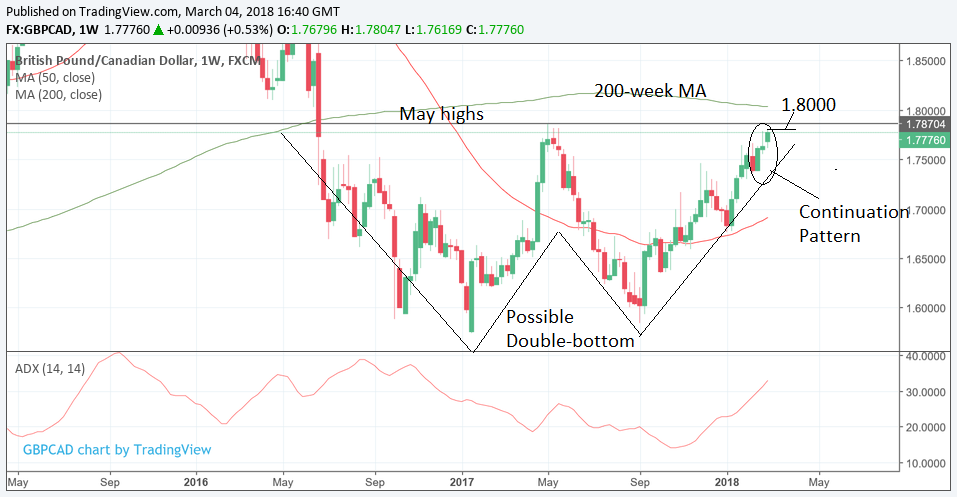The Pound-to-Canadian Dollar Rate Forecast for Week Ahead

A high-probability continuation pattern signals bias to expecting more upside in the week to come.
The Pound-to-Canadian Dollar exchange rate is rallying as the dominant short-term uptrend advances.
It is now approaching the May highs at 1.7840 as we maintain our overall positive technical stance on the exchange rate.
We also note the exchange rate is in the process of forming what could be a high-probability continuation pattern on the weekly chart (circled below) which could signal more upside to at least 1.8000.
This pattern indicates a high (>80%) probability of an extension of between 200-300 basis points, which would take it up to a target at around the 1.8000 level.
The pattern is composed of three days of activity. The first and third days have a much longer more bullish range than the middle day which is squatter in comparison and must be less than half the height of the true bodies of the first and third candles.
The final criteria for the continuation pattern to be valid is that the ADX indicator, which is in the lower pane of the chart above should be between 20-35, which it is at slightly over 30 on GBP/CAD. It must have been rising over the last 4 days, which it also been doing on GBP/CAD.
Potential Double-Bottom Heralds New Bullish Phase
It is also possible that GBP/CAD may have formed a large double bottom chart pattern since June 2016 (see chart below).
Double-bottoms look like the letter 'W' and form at market lows, they herald a reversal from bearish to a bullish trend.
A break above a level called the neckline at the intervening peak is usually required for confirmation of more upside, the neckline, in this case, is at the level of the May highs at 1.7840.
Such a break would then probably see the exchange rate move higher by a minimum of the height of the pattern multiplied by the golden mean (0.618) extrapolated higher from the neckline.
This gives an upside target of 1.9030.
The 200-week MA at 1.8041 is a formidable obstacle in the way of the exchange rate reaching its target and its possible it may stall of reverse at it, so for stronger confirmation of more upside traders should wait for a break above 1.8200 to confirm a clearance of the moving average as well.
Get up to 5% more foreign exchange by using a specialist provider to get closer to the real market rate and avoid the gaping spreads charged by your bank when providing currency. Learn more here.
Data and Events to Watch for the Canadian Dollar
The main event for the Canadian Dollar in the week ahead is the Bank of Canada (BOC) monetary policy meeting at which no change in the base interest rate of 1.25% is forecast.
Although recent GDP data undershot expectations by rising only 1.7% instead of 2.0% forecast, economists are generally impressed with Canadian economic growth.
"Economic advances in Canada will remain slightly above potential, which is estimated by the Bank of Canada at about 1.4% for 2018. In such conditions, further key rate increases will eventually be necessary, but the exact timing of their announcement will depend on the change in risks," says Desjardins senior economist Benoit P. Durocher.
The main overhanging risk which has prevented a more aggressive tightening policy from the BOC has been fears about the impact of the renegotiation of the North Atlantic Free Trade Agreement, or NAFTA.
There is a risk that the US could decide to withdraw from NAFTA which would impact negatively on Canadian exports and this has kept interest rates lower than they would have been without the NAFTA risk.
The other main release in the coming week is employment data which is scheduled for release at 13.30 on Friday, which is the same time as US Non-Farm Payrolls (NFP).
Canadian data is expected to show a rise of 17.5k workers in February and an unemployment rate of 5.9%.
The lower unemployment is generally the better it is for a currency, so if data on Friday is better-than-expected it will help support CAD.
Data and Events to Watch for the Pound
The Pound was largely unmoved at the end of last week as Prime Minister May delivered her 'road to Brexit' speech which offered little fresh information to investors.
The response from Europe has been mixed and there remains a question mark over whether the EU will sanction a transitional deal at its summit on March 23. A failure would sanction a transitional period would be negative for the Pound, but markets appear to be willing to keep Sterling and the Euro stuck in the already mentioned tight range until they get a clear steer on how talks are progressing.
In the week ahead there are reports the Chancellor Philip Hammond will also be making a Brexit speech, focusing on the subject to a bespoke deal for the UK's dominant services sector. The UK has a services sector trade surplus with Europe so this could be important for the Pound, however, whether Hammond's proposals are likely to be accepted by Brussels is a different matter.
Staying on the topic of the services sector, the data highlight of the week comes in the form of IHS Markit's services PMI for February which will give a steer as to how well the sector performed.
Markets are looking for a reading of 53.3, which would be a shade up on January's 53.0. A beat on this estimate could give Sterling a nudge higher. A miss, the opposite effect.
However, with the Brexit being the key driver of Sterling at present we would expect a large deviation from expectations in the data to move the currency; particularly against the Euro.
Watch Friday's trade balance data for January, which is forecast to show the deficit narrowing to -12.2bn from -13.6bn previously, when it is released at 09.30 GMT.
Industrial production is out at the same time and is forecast to show a 1.1% rise month-on-month in January.
Manufacturing production, also out at 09.30 on Friday, is forecast to rise by 0.2% in January compared to the previous month.
Get up to 5% more foreign exchange by using a specialist provider to get closer to the real market rate and avoid the gaping spreads charged by your bank when providing currency. Learn more here.






